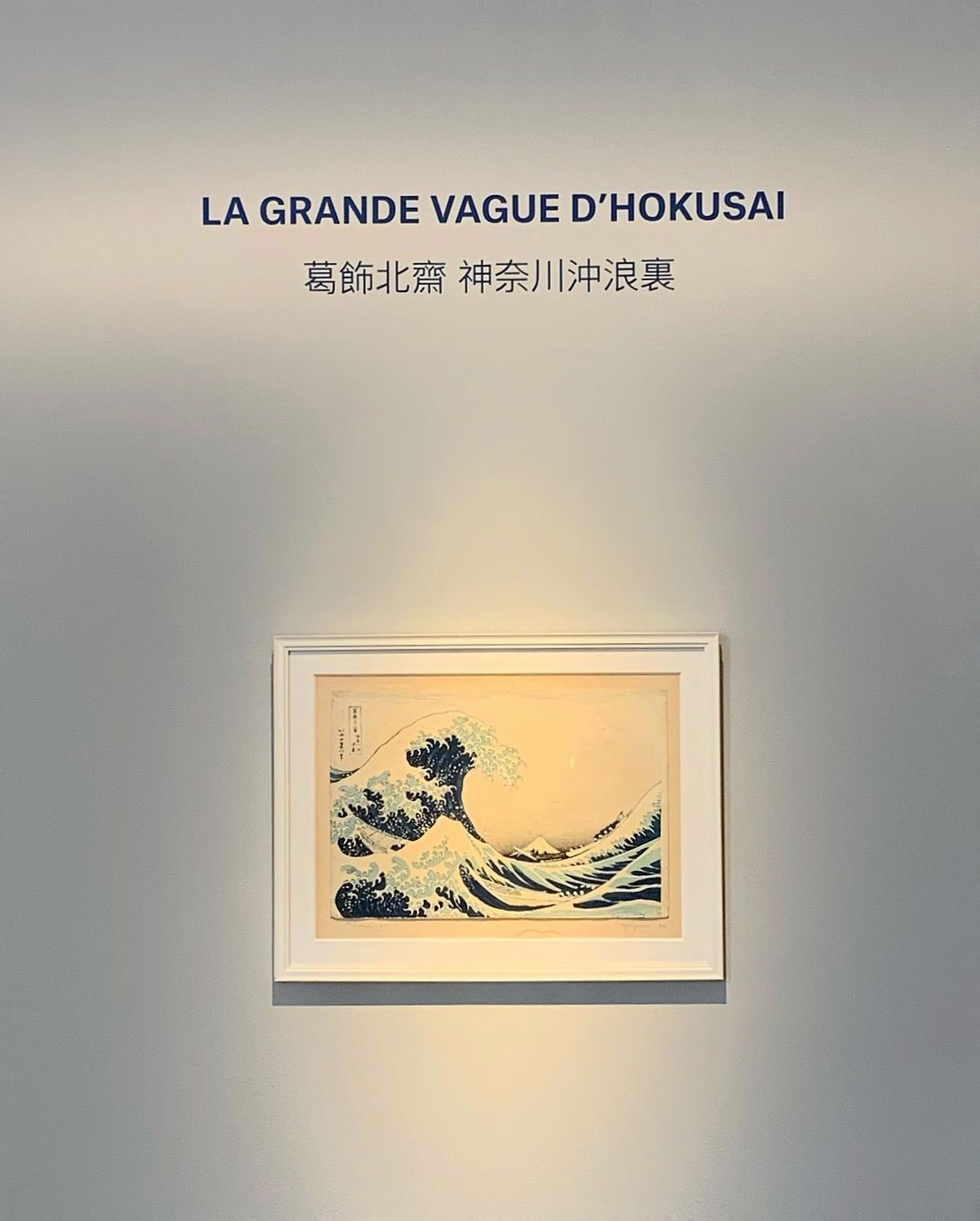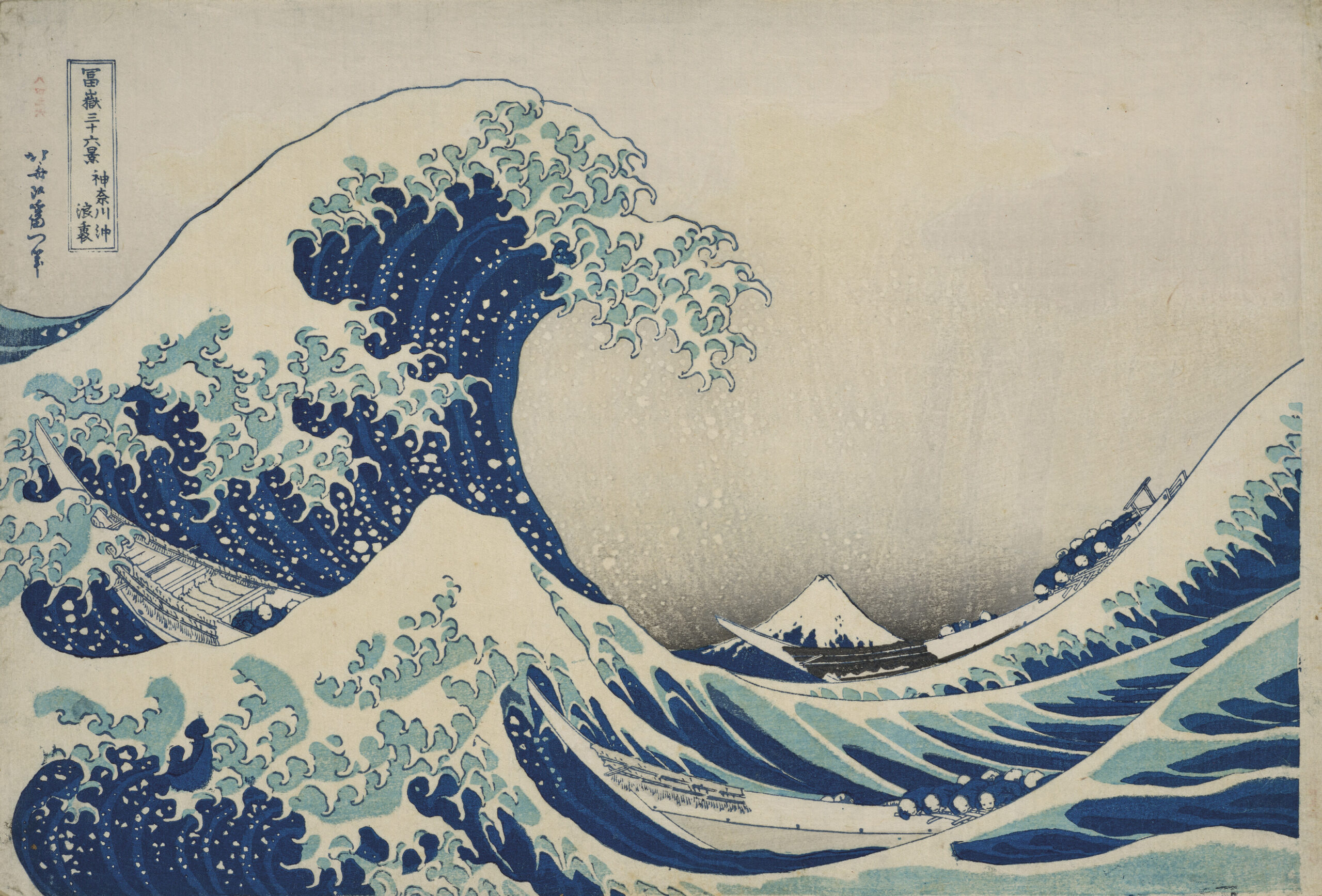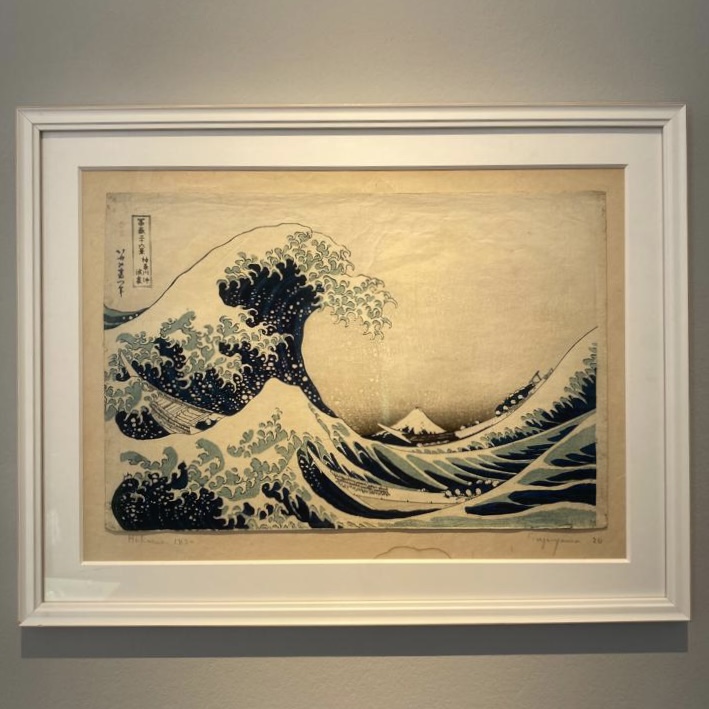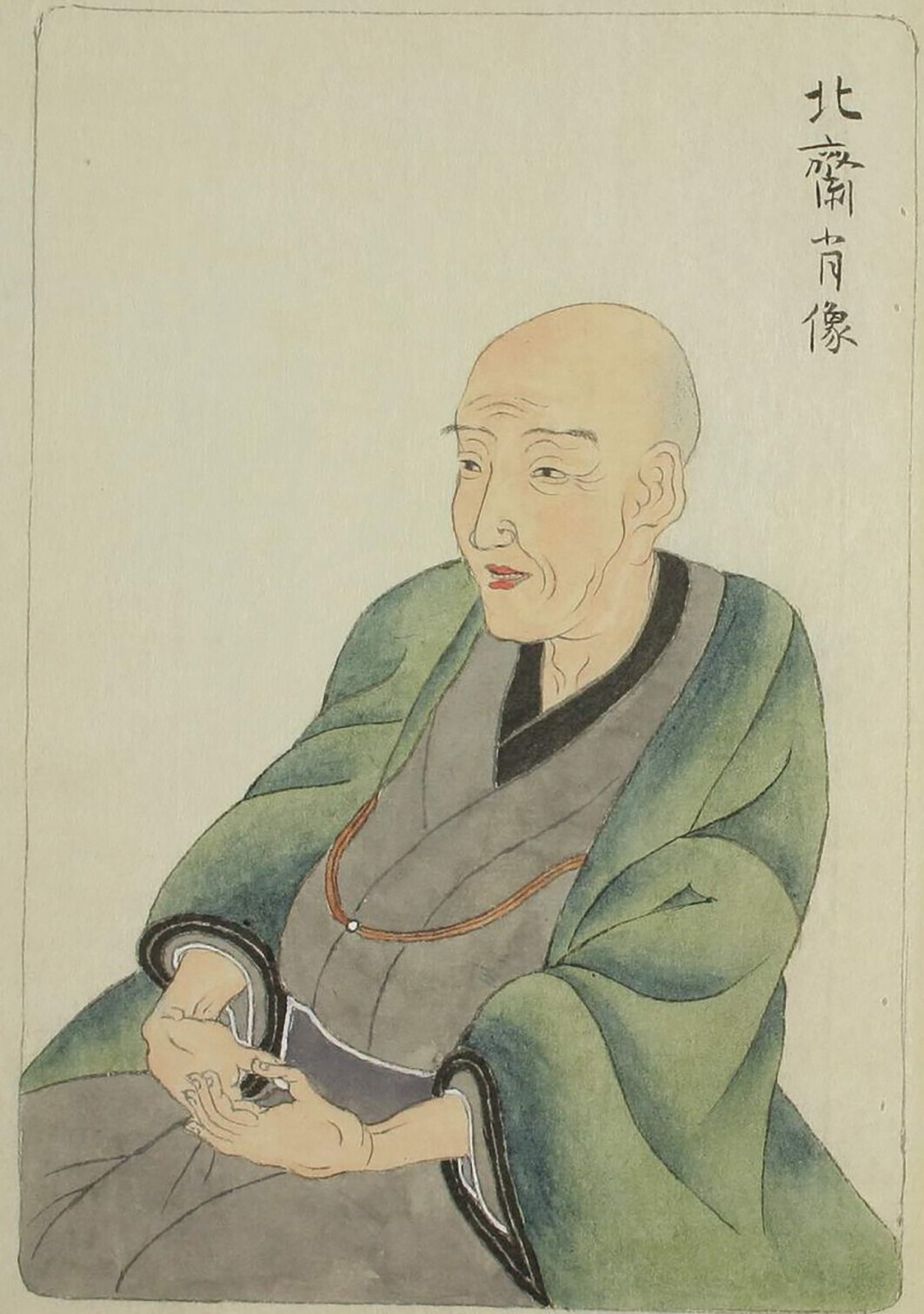
Katsushika Hokusai (Japan, 1760-1849)
Kanagawa oki nami ura (La Grande Vague de Kanagawa) [“La Vague”]
Estampe de la série Fugaku sanjurokkei (Les trente-six vues du Mont Fuji), signée Hokusai aratame Iitsu hittsu , publiée par Nishimuraya Yohachi (Eijudo).
26 x 38,4 cm. (10 1/4 x 15 1/8 in.)
Provenance
Previously in the collection of William Dannat Haviland, collected in the 1930s (by repute) and gifted to the current collector’s family in the 1950s.
Price Realised EUR 882,000 at Christie's Paris, 14 June 2023



Hokusai’s Great Wave
It still upsets me when I think of all those newspapers, magazines and other media worldwide, that jumped on this acknowledged masterpiece by Hokusai, popularly known as the Great Wave, in their learned comments on the 3/11 tsunami that hit the Tōhoku region of Japan in 2011. No such thing as an impeding drama has ever been on the mind of the seventy years old ‘Mad about Drawing’ Hokusai when he in 1830 turned to landscape prints and created this iconic image. Above all, he wanted to demonstrate that we live in perfect harmony with nature. And what is more, we are even surrounded by beautiful nature. This is what he not only showed to his Japanese audience at the time, but that is probably also why we, all over the world, have come to embrace Japan as a country of harmony and mere beautiful scenery.
This was not only the message in his series of Thirty-six Views of Mount Fuji (1830-34) of which the Great Wave is part, but also in his various other series of landscape prints, such as, most notably, Going the Round of the Waterfalls in All Provinces (1831-32) and the Remarkable Views of Bridges in All Provinces (1834). Yet, as early as in 1893, in the catalogue of the first public exhibition of paintings by Hokusai and his pupils at the Boston Museum of Fine Arts, Harvard graduate Ernest Fenollosa (1853-1908) – professor of philosophy and political economy at the Imperial University of Tokyo (1878-86, now Tokyo University), co-founder of the Tokyo School of Fine Arts (1887, now the Tokyo University of the Arts) and the Tokyo Imperial Museum (1882, now the Tokyo National Museum),of which he became director in 1888 – having traveled widely in Japan, would remark that ‘It is not Japan that he shows us, but a highly imaginative Hokusaiish world which he builds up for us. /…/ But we have never with conscious effort been able to observe /…/ a markedly Hokusaiish landscape’ (p. xii).
The fantastic cohabitation of people in the surrounding scenery, inclusive of Mount Fuji, can be inferred from the almost total absence of people admiring the mountain, let alone paying attention to its presence. Checking all of the forty-six prints that would eventually make up the series in spite of having been announced originally as Thirty-six Views of Mount Fuji, we can identify beyond any doubt the man pointing at the mountain in the print of the elliptical pine tree at Aoyama, and surely also the boy with some package on his back in the view of the balcony of the Gohyaku Rakanji Temple, who is seen pointing at the mountain, as well as one of the ladies in the design of the snowy morning at Koishikawa.We are already less sure about the man with a load from a yoke over his shoulders in the print of the Suruga Heights in the Eastern Capital who might, indeed be looking at the mountain, and then there is possibly the man leading a horse in the print of Hodogaya on the Tōkaidō, as well as one of the travelers in the print of Nakahara in the Province of Sagami. Indeed, these are no more than six people at the most, in all of the forty-six designs of the series. And what is more, surprisingly not even one of the seven people gathered at the Fuji-Viewing Tea-house at Yoshida on the Tōkaidō seems to be paying any attention at the 3776 meters high mountain.as well as one of the travelers in the print of Nakahara in the Province of Sagami. Indeed, these are no more than six people at the most, in all of the forty-six designs of the series. And what is more, surprisingly not even one of the seven people gathered at the Fuji-Viewing Tea-house at Yoshida on the Tōkaidō seems to be paying any attention at the 3776 meters high mountain.as well as one of the travelers in the print of Nakahara in the Province of Sagami. Indeed, these are no more than six people at the most, in all of the forty-six designs of the series. And what is more, surprisingly not even one of the seven people gathered at the Fuji-Viewing Tea-house at Yoshida on the Tōkaidō seems to be paying any attention at the 3776 meters high mountain.
And yet, for Hokusai, designing this series of prints, the focus was just on Mount Fuji. That is what we see in his compositions, many of which even echo the triangular shape of the mountain in some way. However, for all of the people in the prints, the mountain seems to be nothing else but a coincidental presence, not playing any role of importance in their lives. This demonstrates how we can live in harmony with the nature surrounding us. And it is therefore that we may well conclude that it is most unlikely that the high-rising waves off Kanagawa would be going to swallow the oarsmen. There cannot be any doubt, they will make it to the Izu Peninsula and Awa Province, now Chiba Prefecture, to collect their cargo of fish and vegetables destined for Edo, rowing their boats through indeed some high rising waves.
The now popular common title of the Great Wave to refer to this print, properly titled Under the Wave off Kanagawa, Kanagawa oki namiura, would suggest that it is the wave that is the main feature in the artist’s composition. However, his earliest ‘proto-wave’ design, a plate in the album The Threads of the Willow, Yanagi no ito, published in 1797 by Tsutaya Jūsaburō (1751-1797), was obviously inspired by a painting by Shiba Kōkan (1747-1818) of the beach at Enoshima Island with Mount Fuji on the horizon, that he in 1796 donated to the Enpukuji Shrine at Atagoyama in the south of Edo, as one of this artist’s many acts of self-promotion. When Hokusai joined the thousands of people flocking to the shrine to see this novel Kōkan painting, he was obviously captured by the movement of the waves rolling onto the beach in the foreground.And his immediate reaction must have been something like ‘That’s nice, but I can do better.’
In his plate in the Threads of the Willow album, Hokusai places the wave much more prominently in the foreground than it is in the Kōkan painting, also emphasizing the motion of the wave rolling onto the shore by placing a party of woman tourists from Edo in conversation with some locals also directly in the foreground to the right. In Kōkan’s painting we just see the small figures of a local fisherman with his assistant somewhat further in the distance. We cannot, alas, know how the Edo audience reacted, but most likely it must have been obvious that by challenging Kōkan, Hokusai, who had only established himself as an independent artist just four years earlier, in 1793, had to be considered a serious new talent and apparently gifted with greater compositional skills than the thirteen years older Kōkan.
Even after this brazen act, the rolling wave kept him thinking of ways to give it more power. In the early 1800s he saw a chance to include a design of a coaster with a large sail, a so-called bezaisen, encountering a high rising wave to the right, as one in a series of five prints with a decorative border in imitation of a European picture frame and the titles written horizontally in characters, also in imitation of European writing. This design bears the title Honmoku Off the Coast of Kanagawa, Kanagawa oki honmoku no zu, that is just out at sea from present-day Yokohama. In another print of around the same time, equally with a decorative border and the title this time written horizontally in kana syllabary script, Hokusai includes a design of three Cargo Boats Passing through Waves, Oshiokuri hatō tsūsen no zu,indeed quite a similar idea as in the Great Wave. In both designs, he uses accents in grey and even black to indicate the upward movement of the waves, whereas he would in the design of the Great Wave use two shades of blue, one brighter, the other a deeper blue, to get this effect. Quite interestingly, the foam at the crests of the waves in these early Hokusai prints is still quite similar to what we first saw in the Kōkan painting of 1796. It is only in 1823, in his model book of comb decorations, that Hokusai develops the finger-like crests that we later, in 1830, also see in the Great Wave.Quite interestingly, the foam at the crests of the waves in these early Hokusai prints is still quite similar to what we first saw in the Kōkan painting of 1796. It is only in 1823, in his model book of comb decorations, that Hokusai develops the finger-like crests that we later, in 1830, also see in the Great Wave.Quite interestingly, the foam at the crests of the waves in these early Hokusai prints is still quite similar to what we first saw in the Kōkan painting of 1796. It is only in 1823, in his model book of comb decorations, that Hokusai develops the finger-like crests that we later, in 1830, also see in the Great Wave.
As it was first published in 1830 titled Under the Wave off Kanagawa, or also In the Hollow of the Wave off Kanagawa, Kanagawa oki namiura, the print must have been an immediate success. The blocks were reprinted numerous times and although it is difficult to cite a precise number, from the wear of the blocks that I have seen over the years, I would say that the total is at least somewhere between twelve and fifteen thousand impressions, maybe even more. The wear of the blocks in this copy, most noticeable in the outlines, is quite modest. We can notice some breaks in the bottom lines of the title cartouche which we would normally first see at the left bottom, but not here, so maybe this is just a matter of sloppy inking of the block. Another small break that we can often see and also in this copy,is noticeable just below the top of Mount Fuji on the right slope. And certainly, there is no break in the outline of the wave just to the right of the foremost right boat often showing in much later impressions. Otherwise, we can just notice, that, indeed, there are some minor breaks in the second and third crests of the wave. And having been exposed to daylight for some period of time, both the pinkish cloud – that anyway can be seen only rarely in even very good copies – and the yellow on the boats are faded. And with its measurements of 260 x 384 mms leaving a wide margin to the right and showing the end of the blocks, this is certainly one of the larger copies that survive today.Otherwise, we can just notice, that, indeed, there are some minor breaks in the second and third crests of the wave. And having been exposed to daylight for some period of time, both the pinkish cloud – that anyway can be seen only rarely in even very good copies – and the yellow on the boats are faded. And with its measurements of 260 x 384 mms leaving a wide margin to the right and showing the end of the blocks, this is certainly one of the larger copies that survive today.Otherwise, we can just notice, that, indeed, there are some minor breaks in the second and third crests of the wave. And having been exposed to daylight for some period of time, both the pinkish cloud – that anyway can be seen only rarely in even very good copies – and the yellow on the boats are faded. And with its measurements of 260 x 384 mms leaving a wide margin to the right and showing the end of the blocks, this is certainly one of the larger copies that survive today.And with its measurements of 260 x 384 mms leaving a wide margin to the right and showing the end of the blocks, this is certainly one of the larger copies that survive today.And with its measurements of 260 x 384 mms leaving a wide margin to the right and showing the end of the blocks, this is certainly one of the larger copies that survive today.
As for its pedigree, the print is associated with the Havilands, a family originating in England but emigrating to America in the seventeenth century. Among the family members it is especially Charles Field Haviland (1832-1896) who is known for his vast Japanese collections, sold in 18 sales at Drouot, Paris, in the years 1922 to 1927. In the early nineteenth century, David Haviland (b. 1814) opened a shop of porcelains in New York which is how the family business started. Due to the economic crisis that hit the United States, he then moves to Southwestern France, settling in Limoges, the French center of the porcelain industry with already some more than thirty factories in operation in 1850. Here, David, who is soon joined by his already mentioned nephew Charles Field Haviland,founds Haviland et Compagnie in 1864 which would dominate the local industry during the last quarter of the nineteenth century. It was especially William Dannat Haviland who joined the company in 1903 to become its manager from 1919, who took a great interest in both Japonism and Art déco. He made the later Impressionist painter Félix Bracquemond (1833-1914), who had been working with the Sèvres porcelain factory, the artistic director of his Haviland de Limoges company, and worked with artists such as René Lalique (1860-1945), Édouard-Marcel Sandoz (1881-1971), and Jean Dufy (1888-1964) for his porcelain designs. It was Siegfried Bing (1838-1905) one of the major dealers of Japanese art in Paris and the publisher of the monthly Le Japon Artistique,who introduced art déco in the Limoges porcelain industry in 1895 from his Maison Bing de l’Art Nouveau.
The print of the Wave off Kanagawa was presented to the family in the 1950s and is said to have been first acquired in the 1930s. The numerals in red, reading 8496, stamped twice on the verso of the print (and, alas, also showing vaguely on recto) cannot, as far as I am aware, be associated with some known Japanese origin/merchant, although I have seen quite a few examples of such numerals. Another illegible seal of an earlier collector bottom left on verso, must remain unidentified.
Dr. Matthi Forrer
Senior Researcher Japan Collections, National Museum of Ethnology, Leiden, The Netherlands










